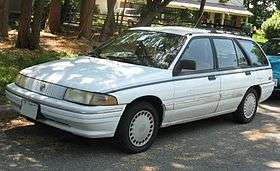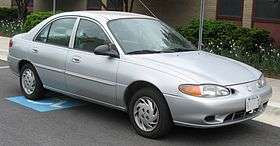Mercury Tracer
The Mercury Tracer is an automobile that was marketed by Mercury from the 1988 through 1999 model years. Introduced as the successor to the Mercury Lynx, three generations of the Tracer were sold in the United States and Canada. Initially introduced as a subcompact, the two succeeding generations were sold in the compact segment. Throughout its production, the Tracer was marketed as a hatchback, four-door sedan, and five-door station wagon.
| Mercury Tracer | |
|---|---|
 1993–1996 Mercury Tracer 4-door | |
| Overview | |
| Manufacturer | Mazda (1988–1989) Mercury (Ford) (1991–1999) |
| Production | 1987–1989 1990–1999 |
| Model years | 1988–1989 1991–1999 |
| Body and chassis | |
| Class | Subcompact car (1988–1989) Compact car (1991–1999) |
| Layout | FF layout |
| Chronology | |
| Predecessor | Mercury Lynx |
| Successor | Ford Focus (Mexico) |
After the 1999 model year, Mercury ended sales of the Tracer. While the model line was not directly replaced, its Ford Escort counterpart was replaced by the Ford Focus.
The replacement for the Ford Escort-derived Lynx, the first generation of the Tracer was a modified version of the Asia-Pacific market Ford Laser, itself a variant of the Mazda 323.[1][2] In 1990 for the 1991 model year, the Tracer became the Mercury counterpart of the Ford Escort in North America.[3] All three generations of the Tracer were based on variations of the Mazda 323/Protegé.
The Ford Focus would serve as a common replacement for both the Ford Escort and the Mercury Tracer.
First generation (1988–1989)
| First generation | |
|---|---|
 | |
| Overview | |
| Also called | Ford Laser (KC) |
| Production | 1987–1989 |
| Model years | 1988–1989 |
| Assembly | Hermosillo, Mexico[4] Taoyuan City, Taiwan Hiroshima, Japan |
| Body and chassis | |
| Class | Subcompact |
| Body style | 3-door hatchback 5-door hatchback 5-door station wagon |
| Platform | Mazda BF platform |
| Related | Mazda 323 Ford Laser |
| Powertrain | |
| Engine | 1.6 L Mazda B6 I4 |
| Transmission | 5-speed manual 3-speed Mazda F3A automatic |
| Dimensions | |
| Wheelbase | 94.7 in (2,410 mm) |
| Length | Hatchback: 162.0 in (4,110 mm) Wagon: 169.7 in (4,310 mm) |
| Width | 65.2 in (1,660 mm) |
| Height | Hatchback: 53.0 in (1,350 mm) Wagon: 53.7 in (1,364 mm) |
For 1988, Mercury introduced the Tracer as its subcompact model range replacing the Lynx. The Tracer became the first Mercury assembled outside of North America. Three-door hatchbacks (for the United States) were assembled by Mazda in Hiroshima; five-door hatchbacks and station wagons were assembled by Ford in Mexico by Hermosillo Stamping & Assembly. Canadian production (three-door and five-door hatchbacks) was sourced from Ford Lio Ho in Taiwan.[5]
Chassis
The Mercury Tracer is an American counterpart of the Australian-market Ford Laser KE, sold in Japan, Asia, and South Africa.[1][2] While sharing a slightly different body, the Laser shared a common chassis with the front-wheel drive Mazda 323, designated the Mazda BF platform. A 1.6L B6 inline-4 from the 323 was offered with the Tracer. For Canadian-market examples, a 71-hp carbureted engine was offered, with an 84-hp fuel-injected engine offered in the United States. A 5-speed manual was standard, with a 3-speed automatic offered as an option.
Body
In line with its Lynx predecessor, the Tracer was offered as in 3-door and 5-door hatchback configurations; for the United States, a 5-door station wagon was offered. Sharing its body panels with the Ford Laser, the Tracer was distinguished by a Mercury grille, badging, and wheel covers; slight revisions were made to the hatchback and station wagon liftgate. Along with a base L trim, the Tracer was offered in GS and LS trim, in line with the Topaz, Sable, and Grand Marquis model lines.
- First-generation Mercury Tracer
 Mercury Tracer five-door
Mercury Tracer five-door 1988–1989 Mercury Tracer three-door
1988–1989 Mercury Tracer three-door 1987 Mercury Tracer hatchback
1987 Mercury Tracer hatchback
Second generation (1991–1996)
| Second generation | |
|---|---|
 1991 Mercury Tracer GS station wagon | |
| Overview | |
| Production | 1990–1996 |
| Model years | 1991–1996 |
| Assembly | Wayne, Michigan, United States Hermosillo, Mexico |
| Body and chassis | |
| Class | Compact |
| Body style | 4-door sedan 5-door station wagon |
| Related | Ford Escort Mazda 323 Mazda Protegé Ford Laser |
| Powertrain | |
| Engine | 1.9 L CVH I4 1.8 L Mazda BP I4 |
| Transmission | 5-speed M5 manual 4-speed F-4EAT automatic |
| Dimensions | |
| Wheelbase | 98.4 in (2500 mm) |
| Length | Wagon: 171.3 in (4,351 mm) Sedan: 170.9 in (4,341 mm) |
| Width | 66.7 in (1,690 mm) |
| Height | Wagon: 52.7 in (1,340 mm) Wagon: 53.6 in (1,361 mm) |
| Curb weight | 2498 lb (1133 kg) |
For 1991, the second-generation Tracer was introduced in early 1990, skipping the 1990 model year altogether. While again derived from Mazda underpinnings, the Tracer became the Mercury counterpart of the Ford Escort as all three model lines were redesigned for 1991, with the 323 becoming the Mazda Protegé sedan in North America. In another shift, the Tracer grew in size, shifting from the subcompact to the compact segment, with all assembly consolidated at Hermosillo Stamping in Mexico.
The Mercury Tracer LTS was named to Car and Driver magazine's Ten Best list for 1991.
Chassis
The second-generation Tracer is derived from the front-wheel drive Mazda BG platform (officially designated the Ford CT120 platform), sharing a 98.4-inch wheelbase with the Escort and Protegé. An 88-hp 1.9L CVH inline-4 is the standard engine (shared with the Escort). From 1991 to 1994, a 127-hp 1.8L BP inline-4 (shared with the Ford Escort GT and Mazda Protegé LX) was offered. A 5-speed manual was standard with both engines, with a 4-speed automatic offered with the 1.9L engine.
Body
The second-generation Tracer was offered in two configurations; along with the station wagon, a four-door sedan replaced the previous hatchbacks (offered as an Escort). While sharing almost no body panels with its Mazda counterpart, the Tracer differed little from the Escort, with the latter distinguished largely by amber turn signal lenses.
During its production, the second-generation Tracer saw few external changes. For 1991, the Tracer was styled with a body-color front grille, replaced by a light-bar grille for 1992 (in line with the Topaz and Sable); for 1996, Tracer sedans received revised taillamps. For 1993, the Tracer was given a drivers' side airbag as a passive restraint, replacing automatic seatbelts; for 1994, the addition of a passenger airbag required a redesign of the dashboard.
In line with other Mercury model ranges, the Tracer was marketed in GS and LS trims, with an LTS trim (Luxury Touring Sedan) serving as the flagship of the model range. Largely the counterpart of the Ford Escort LX-E (the four-door version of the Ford Escort GT), the LTS was powered by a 127hp Mazda 1.8L engine; the LTS was produced through the 1994 model year.
 Mercury Tracer LS
Mercury Tracer LS 1992–1996 Mercury Tracer GS
1992–1996 Mercury Tracer GS.jpg) Mercury Tracer LS "Trio"
Mercury Tracer LS "Trio" Mercury Tracer LTS
Mercury Tracer LTS
Third generation (1997–1999)
| Third generation | |
|---|---|
 | |
| Overview | |
| Production | 1996–1999 |
| Model years | 1997–1999 |
| Assembly | Wayne, Michigan |
| Body and chassis | |
| Body style | 4-door sedan 5-door station wagon |
| Related | Ford Escort Mazda Protegé |
| Powertrain | |
| Engine | 2.0 L SPI 2000 I4 |
| Transmission | 5-speed IB5 manual 4-speed F-4EAT automatic |
| Dimensions | |
| Wheelbase | 98.4 in (2,500 mm) |
| Length | Wagon: 172.7 in (4,387 mm) Sedan: 174.7 in (4,440 mm) |
| Width | 67.0 in (1,700 mm) |
| Height | Sedan: 53.3 in (1,350 mm) Wagon: 53.9 in (1,369 mm) |
For 1997, the Tracer underwent a substantial redesign; although using the same chassis underpinnings, the powertrain and body saw extensive revisions.
Chassis
The third-generation Tracer is derived from the front-wheel drive Ford CT120 platform, used again by Ford, sharing the same 98.4-inch wheelbase as the previous generation. The sole engine is a 110-hp 2.0L SPI 2000 inline-4, paired with either a 5-speed manual or a 4-speed automatic transmission.
Body
The third-generation Tracer again was offered in four-door sedan and five-door station wagon configurations (with the Escort hatchbacks withdrawn altogether). The Tracer largely was distinguished from the Escort by its front fascia and taillamps, along with model-specific wheelcovers. The Tracer station wagon carried over much of the second-generation bodyshell, with updates limited to the front fascia, sideview mirrors, door handles, badging, and dashboard.
As with previous generations, the third-generation Tracer was sold in GS and LS trims, with Mercury selling a Trio appearance package for the GS. The LS trim was distinguished by alloy wheels, leather interior, keyless entry, power windows and door locks, and tachometer.
Following the 1999 model year, the Tracer was withdrawn (along with the Escort station wagon). For 1999, 23,146 examples were sold.[6] The final Mercury Tracer rolled off the assembly line on July 2, 1999.
 Mercury Tracer GS sedan
Mercury Tracer GS sedan- Mercury Tracer LS sedan
 Mercury Tracer GS station wagon
Mercury Tracer GS station wagon
Proposed 2011 revival
Shortly before the end of the Mercury division, Ford planned a revival of the Tracer model line. As Ford confirmed its 2012 model lines with dealers in early 2010, Mercury was to add a compact sedan (derived from the 2012 Ford Focus) as an additional sedan line.[7] Slotted below the Milan, the Focus-derived Mercury was unofficially confirmed to adopt the Mercury Tracer nameplate (ending a 13-year hiatus).[7] Following the planned discontinuation of the Grand Marquis, a 2012 Tracer was to expand Mercury to two sedan lines.[7]
In the summer in 2010, Ford announced the withdrawal of the Mercury division, cancelling the revival of the Mercury Tracer; to expand Ford Focus model range, Ford introduced the premium Titanium trim.
References
| Wikimedia Commons has media related to Mercury Tracer. |
- International Motor Business, Issues 137-140, Economist Intelligence Unit, 1989, page 54
- Special Report: Imports '87, Popular Mechanics, February 1987, page 124
- The Global Strategies of Multinational Enterprises and Government Policies: Ford Motor Company and the Automobile Industry in Canada and Mexico, Volume 2, Isabel Studer-Noguez, 1997, page 340
- Machine that Changed the World, James P. Womack, Daniel T. Jones, Daniel Roos, Massachusetts Institute of Technology, Simon and Schuster, 1990, page 265
- Trade Opportunities in Taiwan, Volume 15, Issues 1-26, Far East Trade Services, Incorporated, 1987, page 19
- "Ford Motor Company Sets New Full Year U.S. Sales Record". Theautochannel.com. Retrieved 2009-04-28.
- "worldcarfans.com|New Ford Focus Badged as Mercury Tracer Due in 2011". 2011.